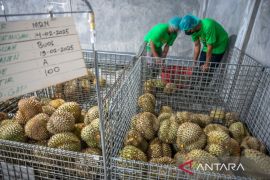Last May, Indonesia set out to enhance its role in international trade by signing a frozen durian export protocol with China’s General Administration of Customs (GACC).
To date, the association noted that eight companies had passed the verification process to export frozen durian to China.
This strategic move aims to position Indonesia as a key supplier alongside Thailand and Vietnam, while boosting trade efficiency and economic growth.
According to Statistics Indonesia (BPS), the country exported 600 metric tons of durian in 2024, valued at US$1.8 million — the highest in the past five years. The main export destinations were Thailand and Hong Kong.
With the new access to China, bypassing intermediary countries such as Thailand and Malaysia, the value is expected to jump significantly.
China is the world’s largest durian consumer, with imports reaching 1.56 million metric tons in 2024, with a total value nearing US$7 billion.
Durian is not only an economic commodity, but also a symbol of the internationalization and high-quality growth of Indonesia’s agricultural sector, Apdurin secretary general Aditya Pradewo emphasized.
Indonesia has several durian production centers in Java, Sumatra, Kalimantan, and Sulawesi. According to the government’s data, 21 of the 27 durian species in the world are found in the country.
With its diverse varieties and distinctive quality, Indonesia is considered ready to become a sustainable supplier for international markets, Pradewo added.
Berlianto Situngkir, Indonesian Consul General in Shanghai, stated that durian has become one of Indonesia's fastest-growing plantation commodities.
Related news: Minister promotes Indonesia’s durian potential to Chinese investors
Related news: Indonesia eyes direct durian exports to China for bigger profits
He said that Indonesia's advantages in terms of its tropical climate, diverse varieties, and vast cultivation areas allow it to supply high-quality durian year-round.
In recent years, frozen Indonesian durian has begun to enter the Chinese market, and the government is now targeting market access for fresh durian.
Within the next two years, he continued, the government is targeting to meet China's requirements for exporting fresh durian by continuing to modernize agriculture, digitize production, as well as improve quarantine standards.
Such efforts will be supported by the International Durian Association through technology transfer, standardization, and brand development.
In order to optimize the opportunity to increase durian exports to China, Indonesia has also invited Chinese investors to develop the durian industry in transmigration areas by taking advantage of the country’s fertile land and productive workforce.
Transmigration Minister Muhammad Iftitah Sulaiman Suryanagara extended the invitation after speaking with a Chinese doctoral student who was interested in learning about the benefits of Indonesia’s transmigration program, not only for Indonesians but also for the Chinese people.
Despite being the world’s largest durian consumer, China lacks the suitable geographical conditions to cultivate durian, while Indonesia’s tropical climate and vast land areas are ideal for developing this premium commodity.
Therefore, he proposed concrete cooperation through investment partnerships between China and transmigration areas in Indonesia to establish export-oriented durian plantations and increase local value-added processing.
Such cross-border cooperation, according to him, would bring dual benefits, strengthening the economy of transmigrant communities, expanding markets for Indonesian fruit exports, and fostering new centers of productive economic growth in transmigration areas.
The minister added that the government is currently preparing more than 500,000 hectares of productive transmigration land for future industrial and agricultural investments.
Addressing challenges
Despite the huge opportunity for Indonesian durian to enter the Chinese market, there are challenges, mainly on how to produce durian that can compete with products from neighboring Southeast Asian countries.
China accounts for 91 percent of global durian consumption. This dominance has earned China the title of the world’s consumption capital, where the “king of fruits” has been spurring innovations in the culinary and foodservice industries.
Durian-themed drinks, desserts, hot pot dishes, and buffets are booming in popularity among young Chinese consumers.
However, Indonesian durian remains unable to tap into this international market, lagging behind Thailand and Vietnam as the largest suppliers of durian to China.
The main obstacles preventing Indonesian durian from entering the Chinese market have been logistics and licensing, according to Eliza Mardian, a researcher at the Center for Reform on Economics (CORE) Indonesia.
The long distance makes shipping fresh durian from Indonesia longer than from Thailand, which naturally impacts quality, she noted.
Therefore, she encourages the government to intensify its support for farmers, such as by conducting extensive outreach on export requirements, facilitating plant health or phytosanitary certification, providing access to capital, as well as building adequate logistics networks and infrastructure, such as frozen storage.
Meanwhile, licensing seems to no longer be a serious obstacle, as the recent agreement on a frozen durian export protocol has certainly opened up opportunities for Indonesian farmers.
Through this protocol, the Indonesian Quarantine Agency becomes the regulator trusted by Chinese authorities to ensure the food safety of frozen durian products destined for China.
The agreement on the China-Indonesia durian export protocol has been welcomed by the regional government in Central Sulawesi, where durian has become one of its leading agricultural commodities.
The Central Sulawesi government has reaffirmed its commitment to further developing the potential of local durian to penetrate the Chinese market, supported by the local chamber of commerce and industry in Parigi Moutong, where farmers have planted more than 110,000 trees on 1,100 hectares of land.
As a major durian-producing region in the province, Parigi Moutong also reportedly has 16 international-standard durian packing houses, which have passed the export protocol audit by the Chinese authorities.
Durian production in Parigi Moutong reached around 6,000 tons in 2024, generating between Rp600 billion and Rp700 billion in transactions between farmers and processing factories.
With the new export route to China, the province targets up to Rp1 trillion (US$64.5 million) in cash flow from durian exports in the first quarter of 2026.
Related news: Indonesia gains approval to export frozen durian to China
Related news: CPO, coal, and durian constitute largest exports to China: Kadin
Editor: Anton Santoso
Copyright © ANTARA 2025












